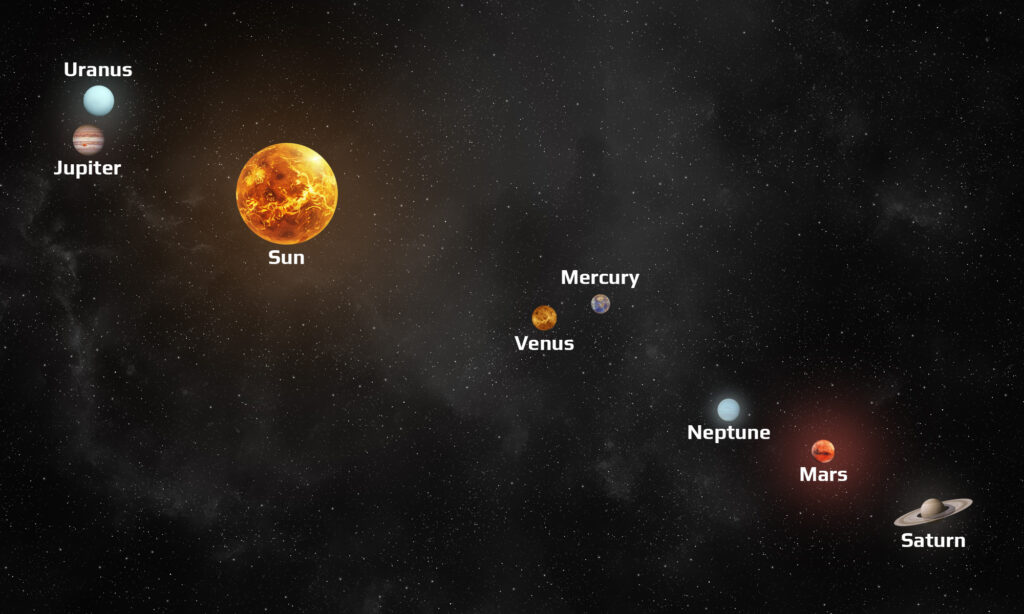Before finally disappearing from the evening sky and starting the conjunction with the Sun, the planets Jupiter and Uranus will be half a degree apart from each other from the point of view of ground observers. This will happen on April 20, and this event will indicate another interesting planetary configuration: all the large planets of the Solar System will gather in the ecliptic sector of a little over 66° in size. This happens quite rarely, but, unfortunately, it will be almost impossible to see it. Let’s try to figure out why.
According to Kepler’s laws, the farther a planet is from the Sun, the faster it moves both in orbit and against the background of stars from the point of view of ground observers. After the conjunction of Venus with Mars at the end of February, these two celestial bodies limited the sector in which the planets gathered to a hundred degrees. “The parade was led” by distant Uranus, which was in the opposition last year. All other bodies— including the Sun and with the exception of the more distant and slower Neptune —gradually caught up with it and started conjoining with each other. Finally, on April 10, Mars “overtook” Saturn, and it was the latter that began to limit the sector from the western side.
Due to the fact that Saturn moves through the sky in an easterly direction faster than Uranus, the angular distance between them continued to decrease, and on the day when Jupiter finally approached Uranus, it reached a minimum value. After this day, the largest planet in the Solar System will become the “commander of the parade”, and since it is closer to the Sun and faster than Saturn, the ecliptic sector with planets will begin to expand.

The sun has been somewhere between the “extreme” giant planets all this time. It is easy to understand that it cannot be otherwise: only under this condition Venus and Mercury fall into the “chain of planets”, which, for ground observers, never move away from our luminary by more than 47° and 28°. Now they are located near the conjunction at a distance of no more than 1.5° from each other at an elongation of 12°. They could be tried to find in the morning sky, but the declination of Mercury is almost 5° less than the solar one (and Venus is even 6°), that is, in our latitudes they rise already in the bright sky shortly before the Sun.
Therefore, of all the rare “alignment of the planets”, we can now see only four objects, and not at the same time. In the evenings, Jupiter and Uranus will set at dusk for about another week — earlier every day, until they finally hide in the near-solar halo in early May. Before dawn, somewhere in the middle of the nautical twilight, Saturn and Mars will appear above the eastern horizon. Neptune has a brightness of about 8th magnitude, that is, it requires at least a small pair of binoculars to observe it even in a normal dark sky. But currently, at the latitude of Kyiv, it rises in the bright sky less than an hour before the Sun. Venus and Mercury could be seen only with the help of professional instruments that allow you to aim at a certain area of the sky according to coordinates and reliably protected from “side” sunlight. That is, from the point of view of entertainment, this “alignment” is far even from the “planetary chain” of mid-April 2022, when four planets visible to the naked eye, plus Neptune, gathered in a 33° wide sector quite far from the Sun. At that time, only Mercury and Uranus were missing for a “complete set”.
Why can’t the April 20th event be considered a “classic” parade of planets? According to the definition adopted in astronomy, more and more planets must gather in as narrow a sector as possible on one side of the Sun. Now two objects are “falling out” of it: firstly, this is our Earth, from which we look and see other planets in approximately the same direction as the sun, and secondly— Mercury, which has passed the lower conjunction and is now located closer to the Earth than the Sun. When viewed from it, all other planets, including Venus, would also “fit” into the sector with an opening of about 70°, but the Earth would be near the opposition.
Earlier we told you why Mercury was so difficult to see in our latitudes.
Follow us on Twitter to get the most interesting space news in time
https://twitter.com/ust_magazine


